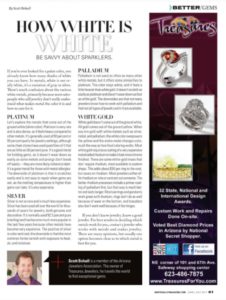How White is White?
By Scott Bohall
If you’re ever looked for a paint color, you already know how many shades of white you can have. In metals, white is not really white, it’s a variation of gray or silver. There’s much confusion about the various white metals, primarily because most salespeople who sell jewelry don’t really understand what makes metal the color it is and how to care for it.
Platinum
Let’s explore the metals that come out of the ground white (silver color). Platinum is very rare and is also dense, so it feels heavy compared to other metals. It’s generally used at 90 percent or 95 percent purity for jewelry settings, although some chain stores have used quantities of it that are as little as 50 percent pure. It’s a good metal for holding gems, as it doesn’t wear down as easily as some metals and prongs don’t break off easily––they are more likely to bend or dent. It’s a great metal for those with metal allergies. The downside of platinum is that it scratches easily and is not easy to repair when gems are set, as the melting temperature is higher than gems can take. It’s also expensive.
Silver
Silver is not so rare and is much less expensive. Silver has been used all over the world for thousands of years for jewelry, both genuine and decorative. It’s normally used 92.5 percent pure (sterling) and has become much more popular in the last few years because other metals have become very expensive. The positive of silver is color and cost; the downside is that the most common forms tarnish with exposure to heat, air, and moisture.
Palladium
Palladium is not used as often as many other white metals, but it offers some similarities to platinum. The color stays white, and it feels a little heavier than white gold. It doesn’t scratch as easily as platinum and doesn’t wear down as fast as white gold. The downsides are that not many jewelers know how to work with palladium and that not all types of jewelry set in it are available.
White Gold
White gold doesn’t come out of the ground white. All gold comes out of the ground yellow. When you mix gold with white metals such as silver, nickel, and palladium, the white color overpowers the yellow and the entire metal changes color, much the way as how food coloring works. Most white gold requires a coating of a very expensive metal called rhodium to make it look more chrome finished. There are some white-gold mixes that don’ require rhodium, most available in custom shops. This adds about $50 per ring to the cost, but saves on rhodium. Most jewelers either offer rhodium on-site or contract out someone. The better rhodium processes include a primer coating of palladium first, but that way is much better and lasts longer. Most earrings and pendants work great with rhodium; rings don’t do as well because of wear on the bottom, and bracelets also don’t work well because of the hinges.
If you don’t know jewelry, know a good jeweler. For best results in deciding which metals work for you, contact a jeweler who works with metals and makes jewelry. There are many opinions, but usually one option becomes clear as to which metal is best for you.
Related posts
Leave a Comment
You must be logged in to post a comment.







